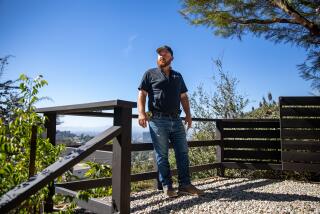Houses for Dead Link Paganism, Prestige
- Share via
RIBARE, Yugoslavia — From a distance, the little houses near the Serbian town of Ribare look like those of any other village.
Despite the modern furnishings, however, the only inhabitants are the souls of the dead, according to an ancient rite that combines paganism, Christianity and the desire for prestige in death as well as in life.
The houses are built over graves and are furnished with tables, chairs, television sets, video recorders and items the deceased enjoyed while alive, such as favorite drinks, cigarettes, cosmetics, toys and clothes.
According to Serbian beliefs that have survived through the centuries, if the dead are not cared for and libations are not regularly brought to their graves, they will return in the form of vampires and werewolves to haunt the living.
“The houses are monuments which are a gift or sacrifice to the dead,” said Ivan Colovic of the Ethnology Institute of the Serbian Academy of Sciences and Arts.
“They fulfill an obligation to the dead and ensure good relations with them,” he said.
“They must also be in accordance with the social status of both the deceased and those who built it.”
Colovic said the practice of building temples to the dead in Serbia, Yugoslavia’s largest republic, dates to the Middle Ages, when they were built for nobles. He said the custom was gradually adopted by other social classes.
Deep-rooted fears that the dead will return if they are not properly cared for, or are forgotten, lie at the heart of Serbian death rites.
The houses come alive with activity on the first Saturday of February, the Serbian day of the dead, or Zadusnica .
On this day, the souls of the dead are believed to come back to Earth for food, drink, shelter and cleansing.
At the Ribare cemetery, scores of people drove by car, tractor and bicycle through mud and sleet this year to lay out lavish feasts at the graves of dead relatives.
The food is offered to all who visit and, at the end of the day, a libation is poured on the ground.
The most common foods are chicken, rice pilaf, cornbread, fruits, sugar cubes, cakes, beer and traditional home-made brandies.
Branislav Dimitrijevic greeted visitors on the patio of the house he built on the grave of his 21-year-old son, Predrag, who was killed in an accident 15 years ago.
His wife, Dobrila, laid out food on a table decorated with handicrafts, a calendar, a clock and pictures of Predrag and his friends.
Another house had a sofa, cupboards and closet as well as stuffed birds because the deceased was a hunter. There were a pack of cigarettes and a lighter on a coffee table because he liked to smoke.
Although these rituals are left over from pre-Christian times, they have been absorbed into the Orthodox Christian faith by many Serbs, especially in rural areas.
“The Orthodox Christian Church assimilated many pagan rituals and gave them a Christian veneer,” said Ivan Kovacevic, a professor of ethnology at Belgrade University.
“The church incorporated many of these rituals from pagan folk religion in order to avoid conflict with the peasants.”
Kovacevic said elaborate monuments to the dead are also considered status symbols by some Serbs, especially rich peasants and those who made their money as migrant workers in western Europe.
He said many of these people were considered second-class citizens by the Communist authorities.
“So they built huge houses, staged enormous feasts on religious holidays and for weddings and built impressive monuments to the dead,” he said.
He told the story of a rich peasant who built a huge and elaborate house over the grave of his father to spite the Communist mayor of his village.
“The peasant knew that the mayor could (ignore) his large house in the village if he wanted to,” Kovacevic said.
“But every time the mayor went to the cemetery to visit his relatives’ graves, he could not avoid seeing the house erected to honor the memory of the peasant’s father.”
More to Read
Sign up for Essential California
The most important California stories and recommendations in your inbox every morning.
You may occasionally receive promotional content from the Los Angeles Times.













